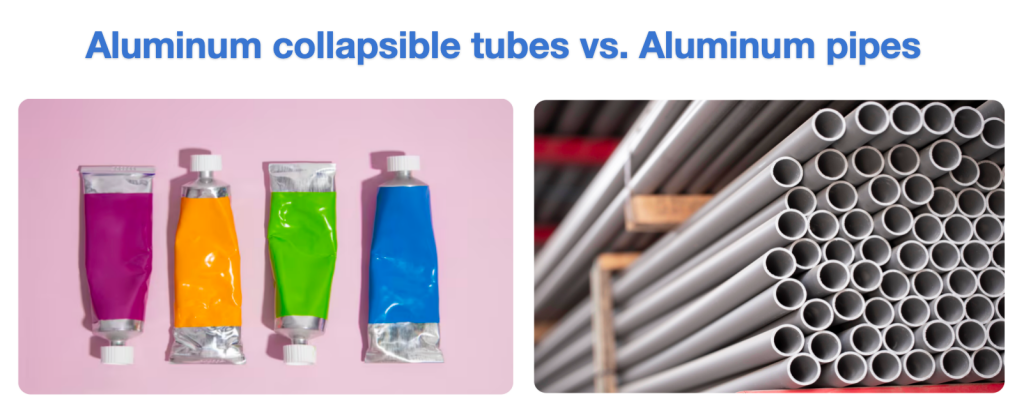Introduction
Tubes pliables en aluminium are widely used in cosmetic, pharmaceutical, and adhesive packaging, but many buyers still confuse them with aluminum pipes. This in-depth guide from Junsam Packaging explains the essential differences between aluminum collapsible tubes and aluminum pipes—from structure, purpose, and materials to production methods and applications. Learn how to choose the ideal aluminum product for your needs, avoid common purchasing mistakes, and ensure compatibility with cosmetic filling lines. Unlike rigid industrial aluminum pipes, aluminum collapsible tubes are soft, hygienic, and printable, making them the ideal solution for creams, ointments, and adhesives. We’ll also explore sustainability advantages and professional tips for choosing the correct diameter, shoulder type, and coating. Whether you’re sourcing packaging for a beauty brand or a pharmaceutical product, this article will help you make informed decisions and partner with reliable suppliers. Discover how Junsam Packaging can support your packaging innovation today.
Aluminum Collapsible Tube vs. Aluminum Pipe: Understanding the Key Differences for Cosmetic, Pharmaceutical, and Adhesive Packaging
In the world of aluminum products, the terms “tube” and “pipe” are often used interchangeably. However, in the cosmetic and pharmaceutical industries, this confusion can lead to serious sourcing mistakes. Many buyers searching for tubes pliables en aluminium online end up finding aluminum pipes—two completely different products designed for entirely different purposes.
At Emballage Junsam, we often receive inquiries from buyers who intend to purchase cosmetic aluminum tubes but mistakenly refer to them as aluminum pipes. To help our partners make accurate choices, this article provides a detailed comparison between aluminum collapsible tubes and aluminum pipes, explaining their differences in function, structure, and application.
1. Why the Confusion Happens
The confusion stems from language and search behavior. Both “pipe” and “tube” describe hollow cylindrical shapes made of metal, but search engines sometimes merge them under similar categories. To non-technical buyers, they might look alike in photos—shiny aluminum cylinders with open ends—but their characteristics are fundamentally different.
In industrial use, aluminum pipes are heavy-duty components designed to transport liquids, gases, or structural loads. In contrast, tubes pliables en aluminium are packaging containers designed to hold, protect, and dispense creams, gels, or ointments.
Understanding the distinction isn’t just technical—it’s essential for product safety, filling line compatibility, and brand presentation.
2. What Is an Aluminum Collapsible Tube?
Un tube pliable en aluminium is a lightweight, flexible container made from pure aluminum slug, typically 99.7% purity. The tube is extruded, annealed, internally coated, printed, and capped. When squeezed, it collapses evenly, dispensing its contents without allowing air or contaminants to enter—ideal for preserving product integrity.
Key Characteristics:
- Material: Soft, pure aluminum
- Structure: One-piece seamless body with sealed bottom and tapered shoulder
- Function: Holds creams, ointments, toothpaste, cosmetics, adhesives, etc.
- Internal Coating: Epoxy or lacquer to prevent product-metal interaction
- Impression: Custom branding, color matching, and decoration
- Closure: Membrane seal, screw cap, or flip top
Advantages for Packaging:
- Airtight and hygienic
- Protects light-sensitive and oxygen-sensitive formulas
- Smooth, premium aesthetic suitable for high-end cosmetics
- Fully recyclable
In short, aluminum collapsible tubes are functional, protective, and brand-enhancing containers—far removed from industrial aluminum pipes.
3. What Is an Aluminum Pipe?
Un aluminum pipe is a rigid, hollow metal cylinder designed primarily for transporting fluids or for structural use. It’s measured by the inside diameter (ID) and wall thickness, as flow capacity depends on the internal dimensions.
Typical Characteristics:
- Material: Aluminum alloy (6061, 6063, etc.) for strength
- Structure: Straight, open-ended tube
- Purpose: Transport of liquids/gases, framework construction, machinery components
- Surface: Bare, uncoated metal
- Manufacturing: Extrusion and drawing for precise dimensions
Aluminum pipes are durable and corrosion-resistant, but they are not flexible or collapsible, and they lack any internal coating, sealing, or decoration. That makes them unsuitable for cosmetic or pharmaceutical filling lines.
4. The Key Differences Between Aluminum Pipes and Aluminum Collapsible Tubes
Feature | Aluminum Pipe | |
Purpose | Packaging for cosmetics, pharmaceuticals, and adhesives | Industrial transport or construction use |
Material Type | Pure aluminum slug (soft and flexible) | Alloyed aluminum (rigid and strong) |
Structure | Seamless, closed at one end | Open at both ends |
Wall Thickness | Thin (0.1–0.4 mm) | Thick (1–5 mm or more) |
Flexibility | Easily squeezable | Rigid and non-deformable |
Surface Finish | Lacquered and printed | Bare or anodized metal |
Measurement Standard | Outer diameter (OD) | Inner diameter (ID) |
Applications | Creams, ointments, toothpaste, adhesives | Plumbing, machinery, frameworks |
Coating / Decoration | Internal lacquer + external printing | None |
Durabilité | Lightweight, recyclable packaging | Reusable industrial component |
This table visually demonstrates that while both are “aluminum cylinders,” they are designed for completely different functions.
5. Why the Confusion Matters for Buyers
Ordering the wrong product can lead to severe production delays and financial losses. If a buyer orders aluminum pipes instead of collapsible tubes:
- Filling machines can’t seal or crimp them.
- They’re too thick and rigid for squeeze functionality.
- They lack internal lacquer, which can cause a chemical reaction with cosmetic or pharmaceutical ingredients.
- They can’t be printed or branded, which affects their visual appeal.
For brand owners, packaging is an integral part of the overall product experience. An elegant aluminum collapsible tube communicates hygiene, quality, and sustainability—whereas an aluminum pipe does not.
6. How Aluminum Collapsible Tubes Are Manufactured
To understand the quality difference, it helps to know the production steps:
- Slug Extrusion – A small aluminum slug is cold-extruded into a seamless tube.
- Trimming & Annealing – The tube is trimmed to length and heat-treated to achieve softness.
- Internal Coating – An epoxy or lacquer layer is applied to protect product integrity.
- External Printing & Coating – The tube is decorated using offset printing or labeling.
- Shoulder & Thread Forming – The top is shaped and threaded for cap attachment.
- Capping & Sealing – Tubes are fitted with caps and optionally membrane-sealed.
This highly controlled process ensures uniform thickness, smooth appearance, and compatibility with modern filling machines.
7. Choosing the Right Aluminum Tube for Cosmetics and Pharma
When selecting collapsible tubes, buyers should consider:
- Diameter and Length – Common sizes range from 13 mm to 40 mm, depending on product volume.
- Shoulder Shape – Rounded or long-neck types fit different caps or dispensing designs.
- Cap Type – Screw caps, nozzle tips, or flip-top closures.
- Internal Coating – Epoxy-phenolic, Parylene, or customized for reactive formulas.
- Printing & Design – Offset, hot stamping, or silk screening for branding.
- Membrane Seal – Optional for tamper evidence.
At Junsam Packaging, we help clients match tube specifications with filling line requirements to ensure a perfect fit and performance.
8. Sustainability and Recycling Benefits
Both aluminum pipes and tubes are recyclable, but collapsible tubes contribute more to sustainability because they:
- Use less raw aluminum per unit.
- Reduce packaging weight and transportation cost.
- They are infinitely recyclable without any loss of quality.
- Support brands’ eco-friendly positioning in the beauty and healthcare industries.
By choosing aluminum collapsible tubes, brands align with global sustainability trends while offering consumers a premium tactile experience.
9. Why Junsam Packaging Emphasizes Education
At Emballage Junsam, we believe explicit technical knowledge builds trust between suppliers and buyers. Understanding material differences helps customers make informed choices and avoid confusion during the sourcing process.
Our professional team collaborates closely with OEM brands to design, customize, and manufacture aluminum collapsible tubes that meet stringent hygiene and performance standards.
We regularly publish educational content like this to help the market distinguish between packaging materials and industrial metals—ensuring efficiency from design to delivery.
10. Conclusion: The Right Aluminum Product for the Right Purpose
The next time you search for “aluminum tube,” remember:
- Tubes pliables en aluminium are packaging containers for cosmetics, pharmaceuticals, and adhesives.
- Aluminum pipes are industrial components for plumbing and construction.
Both are valuable aluminum products—but they serve very different worlds.
By understanding these distinctions, you can prevent sourcing errors, improve packaging quality, and protect your brand reputation.
For professional guidance, custom design support, or technical advice, Emballage Junsam is ready to help you choose the perfect aluminum collapsible tube solution.
Foire aux questions (FAQ)
1. Are aluminum pipes and aluminum collapsible tubes made from the same material?
No. Aluminum pipes are usually made from alloyed aluminum (like 6061 or 6063) for strength and pressure resistance. Aluminum collapsible tubes are made from soft, high-purity aluminum (around 99.7%) to ensure flexibility and smooth extrusion.
2. Can aluminum pipes be used to fill cosmetic creams or ointments?
No. Pipes are rigid and open-ended, with no coating or sealing system in place. They can’t be filled, sealed, or squeezed like collapsible tubes. Using pipes would lead to leakage and contamination.
3. Why are aluminum collapsible tubes better for sensitive products?
They provide airtight protection, preventing oxygen and bacteria from entering. The internal lacquer isolates the product from metal, ensuring stability for sensitive formulas like creams, gels, and ointments.
4. What are the standard sizes of aluminum collapsible tubes?
Typical diameters range from 11 mm to 40 mm, with capacities from 5 ml to 200 ml. Junsam Packaging can also customize dimensions according to product requirements.
5. Are aluminum collapsible tubes recyclable?
Yes. They are 100% recyclable and can be reprocessed indefinitely without losing quality. Aluminum is one of the most sustainable packaging materials available today.
6. How can I ensure my packaging supplier understands my needs correctly?
Always specify that you require aluminum collapsible tubes for cosmetic or pharmaceutical use and provide the filling line parameters (diameter, cap type, and volume). A specialized manufacturer like Emballage Junsam can offer technical drawings and pre-production samples for confirmation.
About Junsam Packaging
Emballage Junsam is a professional manufacturer specializing in tubes pliables en aluminium for cosmetic, pharmaceutical, and adhesive products. With years of industry experience, advanced extrusion technology, and rigorous quality control, Junsam offers customized packaging solutions that seamlessly combine functionality, aesthetics, and sustainability.
We are committed to helping global brands build strong packaging identities through innovation, precision, and professional service.
📩 For collaboration or technical consultation, contact Junsam Packaging — your reliable partner in aluminum tube packaging.


